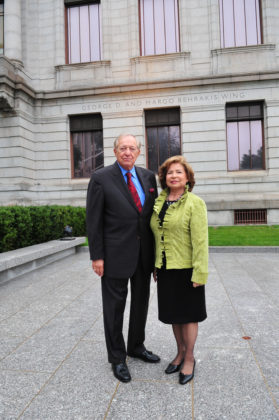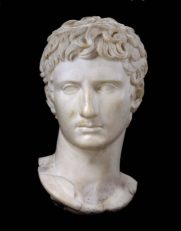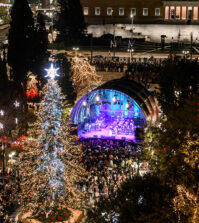Art of Ancient Greece, Rome and the Byzantine Empire George D. and Margo Behrakis Wing, Level 2 Opens December at the Museum of Fine Arts Boston
Fine newly transformed galleries at the heart of the Museum of Fine Arts, Boston George D. and Margo Behrakis Wing for Art of the Ancient World, invite visitors to explore nearly 550 objects from one of the finest and most comprehensive collections of Classical art in the world. The new galleries open December 18 and will align with the Museum’s long-standing mission to bring art and people together, and to encourage inquiry, understanding and appreciation of visual language. A popular destination for school groups, new interpretation will engage a wider range of students, many of whom have different learning styles, backgrounds and experiences—making the objects more accessible to the next generation of museumgoers. Narratives throughout the galleries will examine contemporary issues through the lens of the past, asking questions about what it means to be an enlightened citizen, what role religion plays within society, and why the mythical world is an enduring source of fascination—then and now. Additionally, every object will be documented, cleaned and conserved before going on view.

George and Margo Behrakis in front of the building that houses the Art of the Ancient World wing, which the Boston Museum of Fine Arts has named in their honor
Anchored by the Museum’s beloved 13-foot statue of Juno, an immersive gallery dedicated to gods and goddesses recreates the atmosphere of an ancient temple. It introduces the Olympians through their myths and explores how they were worshipped by the ancient Greeks and Romans.
A Byzantine gallery—the first of its kind in New England—showcases a geographically diverse collection of works ranging from the era of Emperor Constantine the Great in the 4th century to the fall of Constantinople in 1453. A highlight of the space, which is modeled on early Byzantine church architecture, is the 15th-century Monopoli Altarpiece, on view for the first time after undergoing a three-year conservation treatment.

 The Romans combined likeness, character and social status to create images that are compellingly human, inventing portraiture as we know it today. In a gallery focused on Roman portraiture, visitors will encounter the faces of emperors and those of everyday individuals.
The Romans combined likeness, character and social status to create images that are compellingly human, inventing portraiture as we know it today. In a gallery focused on Roman portraiture, visitors will encounter the faces of emperors and those of everyday individuals.
Early Greek art, dating from the end of the 10th through 5th centuries BC, is a major strength of the MFA’s collection. Filled with natural light, a gallery dedicated to this formative period includes the frieze blocks from the 6th-century Temple of Athena at Assos in Turkey, a rare example of Greek temple architecture in a U.S. art museum.
A gallery of modern and contemporary works located within the wing—the first such space in a major U.S. art museum—explores the reception of ancient art by 20th- and 21st-century artists. The first of the multiyear rotations features the works of the modern master Cy Twombly (1928–2011), an alumnus of the School of the Museum of Fine Arts, who drew inspiration from Greek and Roman art, myths and poetry. Il Parnasso (1964), an early important painting by the artist that is a promised gift to the Museum, is joined by three bronzes and two original plasters on long-term loan from the Cy Twombly Foundation.
“The MFA’s Greek, Roman and Byzantine collections are foundational to this Museum,” said Matthew Teitelbaum, Ann and Graham Gund Director. “These new galleries will bring to life the richness of Classical art, providing contemporary perspectives on the era’s profound legacy. Original interpretation will allow us to have conversations across time and geography, exploring themes that remain central to our society today, including democracy, religion, philosophy and literature.”
 Bringing to life the richness of the Greek, Roman and Byzantine worlds, these five galleries provide fresh perspectives on an era that provided inspiration for our own modern society. The new spaces will complete a renovated suite of 12 Classical galleries transformed since 2009—most recently, “Daily Life in Ancient Greece” in 2017. The MFA will offer free admission on opening day, December 18, to celebrate the debut of the five new galleries and the reopening of seven galleries in the Behrakis Wing for Art of the Ancient World that have been closed for the past two years to accommodate construction.
Bringing to life the richness of the Greek, Roman and Byzantine worlds, these five galleries provide fresh perspectives on an era that provided inspiration for our own modern society. The new spaces will complete a renovated suite of 12 Classical galleries transformed since 2009—most recently, “Daily Life in Ancient Greece” in 2017. The MFA will offer free admission on opening day, December 18, to celebrate the debut of the five new galleries and the reopening of seven galleries in the Behrakis Wing for Art of the Ancient World that have been closed for the past two years to accommodate construction.
One of the nation’s oldest art museums, the Museum of Fine Arts, Boston (MFA), was founded on February 4, 1870. The Museum opened its doors to the public on July 4, 1876—the nation’s centennial—at its original location in Copley Square. Over the next several decades, the MFA’s collection and visitation grew exponentially, and in 1909, the Museum moved to its current home on Huntington Avenue. Today, the MFA houses a global collection encompassing nearly 500,000 works of art, from ancient to contemporary, and welcomes approximately 1.2 million visitors each year to celebrate the human experience through art as well as innovative exhibitions and programs.















0 comments